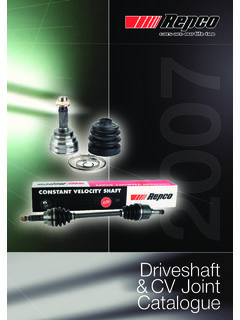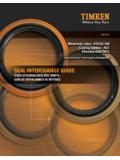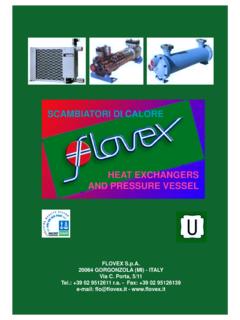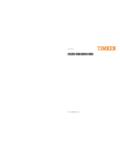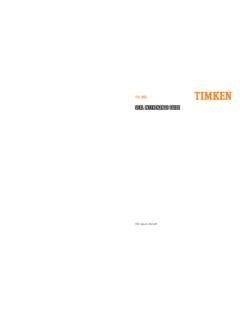Transcription of LANDIS MODEL 30 LEATHER SPLITTER OPERATING …
1 LANDIS MODEL 30 LEATHER SPLITTEROPERATING instructions - SET UP & MAINTENANCEA nyone familiar with the correct setting of the LANDIS MODEL 30 machines should experiencefew difficulties setting or aligning different makes/models stationary knife Splitters. Most othermakes and models use an entirely different knife edge (sharpening) angle, and the specificknife edge (sharpening) angle for each machine make, has to be using a SPLITTER all the bearings should be oiled and, in addition, some oil may bebrushed on the teeth of the SPLITTER gears as proper lubrication is very important andnecessary to prevent undue wear of moving parts.
2 The various parts for oil to apply has beenindicated on the oil chart. Note there are four bearing blocks, two at the left side of the frameand two at the right side. These bearing blocks support the top and bottom rolls. On the leftside blocks you will find holes for oiling at the top of the block close to the edge. The oil holeson the right side bearing blocks are also at the top of the blocks and close to the body of theroll and these oil holes are reached from the inside of the frame. In addition, you will find fouroil holes at the right side of the frame, three of them in the lower roll pivot plate, reference#33, and one in the end of the stud which journals the intermediate driving gear, reference#56.
3 The oil holes in the pivot plate are, one at the pivot stud, two at the bearing of the handcrank shaft and the other at the bearing for the lower roll extension THICKNESS OF WORKOn the front of the SPLITTER you will note the Gauge Plate, ref. #6, which is graduated from 0to 15. These graduation marks indicate the thickness of the work in irons that will beproduced when feeding the LEATHER through the LEATHER THICKNESS MEASUREMENTS THERE ARE 48 IRONS PER INCHS ince 15 iron equal 5/16 inch thickness, being the heaviest work that can be handled on amodel 30 SPLITTER .
4 The upper roll of the SPLITTER is adjusted for various thicknesses of work bymoving the adjusting bar OPERATING lever, ref. #14, to the thickness required. This lever hasan indicator pin which points to the gauge scale and a plunger, ref. #15, which engages aratchet plate to hold the lever in set position. To move the lever the adjusting bar indicatorplunger is first pulled out so as to disengage the ratchet consistency of LEATHER affects the accuracy of splitting and a slight difference inthickness may be expected when splitting hard and soft LEATHER at the same gauge leveling a pair of soles, it is the usual practice to take the thinner sole, place it in theSplitter overlapping the knife, bring down the top roll with moderate pressure on the sole andthen feed the sole through the machine.
5 The heavier to be leveled sole is now fed throughthe machine at the same setting and the thickness will be approximately the same on THE KNIFEWhen setting the knife, make sure that there is no dirt on the bracket to which it is the top roll as high as possible: set the knife against the stops provided for locating it,one at each side of the machine on the lower roll bearings as shown on the sectional the knife against these stops and then bring up the two knife backing screws, ref. #78,against the back of the knife and then back off slightly so that the knife will not be jammedagainst the stops - for leveling soles only, the best setting for the knife is to back up thescrews, ref.
6 #78, 1-1/2 to 2 older machines have badly worn knife stops, also often the very corners of the knifethat pushes against the knife stop, has a break out. This kind of knife should be discardedand replaced with a new or good reground knife. If the knife stops are worn and not smoothand even for a replacement knife to align correctly then align the knife as straight and evenas possible without pressing into the worn part of the knife knife is securely clamped with the knife clamp retaining screws, ref. #82, and the roundhead center knife retaining screw, ref.
7 #81. The setting of the knife in relation to the centerline of the rollers is very important and for this reason the stops on the lower roll bearingswere provided and the knife so positioned will work satisfactorily provided the knife issharpened at the correct ADJUSTMENTSThe two screws seen on top of the machine are to adjust the thickness adjusting bar, ref.#20, so that the top roll is parallel to the knife. These screws are set at the factory and lockedso that when the upper roll is set for thickness of 6 irons, a gauge 1/8 inch thick will passbetween the roller and the edge of the is very little wear on the adjusting parts and this factory setting of the screws toposition the upper roller SHOULD NOT be disturbed.
8 The pressure springs, ref. #46, areproperly set at the factory; pressure may be increased or decreased by using the adjustingscrews, ref. #48, to meet any special conditions in the hardness of the stock that may springs are adjusted with ample pressure to feed hard stock. The check nuts, ref. #51,just above each spring, are used to set the bottom roll. The bottom roll should be set so thatthere is a space between the roll and the underside of the knife about 1/64 inch or thethickness of a business card. There should be no occasion to disturb this NOT SPLIT "DRIPPING WET LEATHER "Your machine will look better, last longer and the keen edge of the knife will not corrode andbecome dull from acids in the OF THE KNIFE - KEEP THE KNIFE SHARP & FREE OF NICKS TO OBTAIN BESTPOSSIBLE RESULTSThis is very important as the SPLITTER belongs to that class of cutting, reducing/splittingmachines that require a keen knife ground to the correct angle and properly set to do goodwork.
9 When the knife becomes dull, the work begins to "wedge" or "ride over" the knife andyou will not be able to take a shaving/splitting cut. Also the work will not be even and will varyin thickness. A dull knife may be sharpened by stoning (good quality oil stone is preferred).To remove the knife, loosen the clamp screw, ref. #82, and the center knife retaining screw,ref. #81; NEVER loosen the knife bracket screws, ref. #76, as these screws fasten thebracket and knife to the "frame and it is not necessary nor advisable to remove them. Whenstoning the knife, use a medium grained oil stone or hone.
10 The bevel of the knife is hollowground on the order of a razor and it is stoned the same way. The stone is held flat againstthe bevel, touching at the same time both the cutting edge of the knife and the extreme top ofthe bevel. The edge is stoned on a straight line between these points as shown in theillustration indicating the right way and the wrong way to stone a knife. Do not attempt tosharpen the knife in a hurry or take out nicks by tilting the stone up; this may give you a keenedge, but the edge will not last, in fact it makes the knife blunt, changing the cutting necessitates setting the knife further from the knife stops and the work will vary inthickness.
